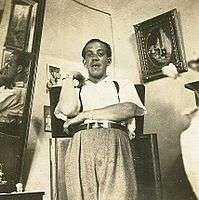Victor Guillermo Ramos Rangel
| Victor Guillermo Ramos Rangel | |
|---|---|
|
Victor Guillermo Ramos in 1935 | |
| Background information | |
| Born |
February 10, 1911 Cúa, Miranda state, Venezuela |
| Died |
December 10, 1986 (aged 75) Caracas, Venezuela |
| Genres | Classical music, Venezuelan popular music |
| Occupation(s) | musician, composer |
| Instruments | Bassoon |
| Associated acts | Venezuela Symphony Orchestra |
Victor Guillermo Ramos Rangel (Cúa, Miranda state, Venezuela, 10 February 1911 - Caracas, 10 December, 1986) was a venezuelan classical musician.
Started his career in the Caracas Musical Declamation Academy (nowadays renamed in honor to José Ángel Lamas), where he graduated as composer. Ramos was one of the first students of Vicente Emilio Sojo and helped him in the recopilation of Venezuelan folk songs.
In 1930 is part of the founders of the Venezuela Symphony Orchestra and the Orfeón Lamas. In this orchestra dedicated to execute the Bassoon.
From 1941 to 1950 was professor in public schools such as: 19 de abril, Rubén González, Ricardo Zuloaga and Gabriela Mistral, in Caracas.
In 1945 worked for the Education Ministry and was music professor in the Cultural Direction of Caracas. In 1947 married Dilia Díaz Cisneros, with whom he had three sons. From 1944 until 1978 was Professor of Theory, Solmization and Music History in the José Ángel Lamas Superior Music School. In 1978 participated in the documentary about his hometown, for the series Pueblos de Venezuela on YouTube (Towns of Venezuela), of filmmaker Carlos Oteyza.
Along with the Venezuela Symphony Orchestra traveled to Europe and the United States. Also, was member of the National Geographic Society reading club. In his live traveled around the world for general culture and the learning of new languages. Among his compositions, can be mentioned: Lo Eterno, La maravilla (Aprended flores de mi), A José María España, Bambú de caña batiente; and the songs Gota de agua and Amanecer.
See also
- Orfeón Lamas
- Venezuela Symphony Orchestra
References
- Sociedad Orquesta Sinfónica Venezuela 1930-1955. Caracas: Cromotip, 1955.
- Diccionario de la Música en Venezuela. Caracas: Bigott Foundation, 1998.
- Música y músicos de Venezuela. Ernesto Magliano. Caracas: Corporación Venezolana de Guayana, 1976.
- (Spanish) Efemérides: 10 de diciembre de 1986/Muere Víctor Guillermo Ramos Rangel - Encontrarte
